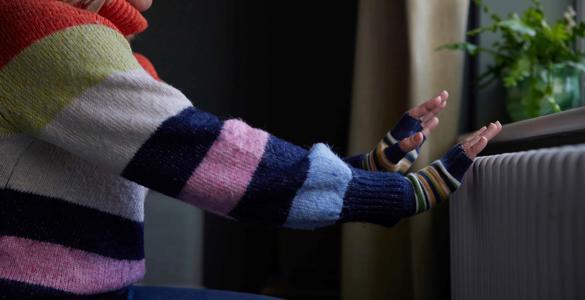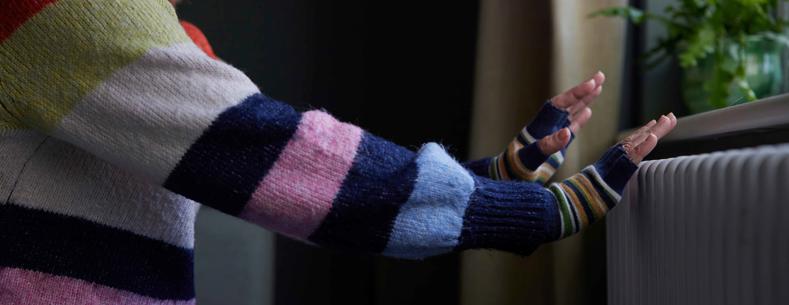As temperatures drop over the winter months, there are renewed concerns about the impact on people living in poor quality housing. The Warm This Winter campaign has estimated that more than half a million adults in Wales are living in cold or damp housing conditions.
Cold homes have direct and immediate impacts on health and wellbeing, which creates extra demand for health services.
This article looks at how cold homes are affecting people’s health, and what is being done across housing and health sectors to tackle the issue.
What is a healthy home temperature?
According to the World Health Organisation (WHO), homes should be heated to a minimum of 18°c, with a higher minimum temperature recommended for vulnerable groups such as older people, children and those with chronic illnesses.
The Welsh Government considers a satisfactory heating regime to be 21°c in the living room and 18°c in other rooms for nine hours a day on weekdays, and for 16 hours on weekends. It sets a higher standard for older and disabled people, stating that 23°C in the living room and 18°C in other rooms achieved for 16 hours each day is considered satisfactory.
What causes cold or damp homes?
There are a range of factors which can contribute to cold or damp conditions at home.
Physical aspects of a home - such as poor insulation, or inadequate or faulty heating systems - can make it difficult to keep warm. Structural issues and poor ventilation make some homes more susceptible to damp or mould problems.
Wales has the oldest housing stock in the UK, and the lowest proportion of energy efficient homes which are EPC C or higher.
But there are many other reasons why households might not be able to keep their home warm enough.
Higher energy prices, alongside wider cost of living pressures, mean that people are struggling to afford heating bills. Last winter, the Bevan Foundation found that almost four out of ten (39%) of people in Wales were forced to cut back on heating, with disabled people and households on low incomes most likely to be going without.
People who need to use their heating a lot - either because they spend more time at home or are more likely to feel the effects of the cold - can find it particularly difficult or expensive to heat their home to an adequate level. This includes older and disabled people, people in ill health, and families with children.
How do cold or damp homes affect people’s health?
Living in a cold home can cause and worsen a range of health conditions.
There is strong evidence that cold housing is associated with cardio-vascular diseases, respiratory conditions and mental ill-health. Cold temperatures can also exacerbate existing conditions, such as diabetes or arthritis, and increase the likelihood of minor illnesses like colds or flu.
Damp or mould within the home produces allergens and toxins that can be particularly harmful to health. For example, children who live in mouldy or damp conditions have a higher risk of developing asthma, allergies, and other respiratory conditions.
Cold and damp can exacerbate health problems to an extent that may lead to death. Around 30% of excess winter deaths in the UK are attributable to living in a cold home, often affecting older people with existing health conditions.
What’s the impact on health services?
Treating illnesses associated with cold homes creates extra demand for health services that are already under strain. Public Health Wales estimates that poor quality housing costs the NHS £95m a year. Around £41m of those costs are associated with the impact of excess cold.
Poor housing can also contribute to delays in discharging patients from hospital, as staff need to make sure patients are going back to suitable homes. As Care & Repair Cymru told a recent Health and Social Care Committee inquiry into hospital discharge:
‘If somebody isn't going home to a warm home or they're not able to put the heating on, then there's going to be a significant increased risk of them being readmitted.’
Increasing the warmth and energy efficiency of homes
The Welsh Government has been taking steps to improve the quality and energy efficiency of social housing. It has published an updated Wales Housing Quality Standard which sets new targets for energy efficiency, and introduced the Optimised Retrofit Programme (ORP) which supports the decarbonisation of existing homes. Around 13,000 properties have so far benefited from or are scheduled to benefit from the ORP.
Those who rent their home privately could be eligible for support with energy efficiency measures through the new Warm Homes Programme (which will replace the existing Nest scheme from April this year), if they live in an energy inefficient property and are on a low income. People with a recognised health condition living in a household with an EPC rating of D or below will also be eligible.
However, the Bevan Foundation has raised concerns about the pace and scale of improvements to be delivered through the Programme. It has estimated that it would take 120 years to improve the energy efficiency of all households living in fuel poverty, based on the scale of the Warm Homes Programme.
The Climate Change, Environment, and Infrastructure Committee has also expressed concerns that people living in private dwellings are being left behind in the Welsh Government’s plans to decarbonise homes.
How are vulnerable groups being supported?
There are several sources of support and advice for people struggling with the cost of living.
Given the significant impact that living in a cold home has on health outcomes, some community services are finding ways to direct people who are particularly at risk to get support with housing and energy concerns.
There are several social prescribing projects which help people to access fuel vouchers, income maximisation advice, or referrals to home improvement services. The Healthy Homes, People, Lives & Community project in North Wales offers advice, support, and referral options to help address the root causes of fuel poverty and health problems amongst vulnerable groups.
But there have also been calls for more targeted support for people who are most at risk of harm. Asthma and Lung UK Cymru have called for people with serious lung conditions to be offered heating on prescription, something that is being trialled in parts of England and Scotland.
Further reading
Public Health Wales has published a series of reports looking at how health is affected by housing quality, and what is needed for a home to be healthy.
Article by Gwennan Hardy, Senedd Research, Welsh Parliament






